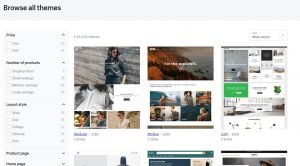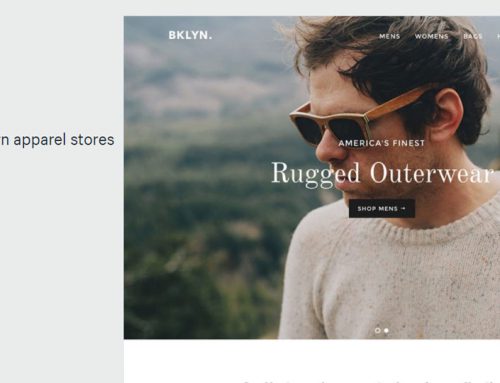In this article we’ll be going over how to pick the best Shopify theme for your business using a checklist of items that I recommend to every business that is opening a new store.
If this is your first time joining my Shopify Tutorials for Beginners series, make sure to subscribe to my newsletter to get updates on my newest articles.
To start with, all themes that you find on the shopify theme store come with core features that are important for all stores.
You can see in the theme store that all themes are SEO ready to Mobile-friendly. And one of the best features is that all of the themes on the store come with the theme editor, which allows you to make all the changes that you need to by dragging and dropping everything into place. This is very important for businesses who are making changes by themselves and have limiting coding abilities.

ABOUT MEDIA MIKE
I’ve been helping businesses (small and big) establish themselves online over the past 15 years, for myself and others. Now I want to share what I’ve learned.
Working with a Budget
Which brings me to my first questions that I ask businesses choosing their theme design: How big is your budget? This budget should be all inclusive, meaning it should factor in everything from any special coding or development work that is requried, the images being used on the site, the theme design, and everything else it takes to get a site up and running.
And the biggest reason why I ask this question is to determine whether the business should use a free shopify theme or pay for a premium theme.
So let’s talk about the free theme. Obviously, the free theme is perfect for a lot of businesses based on what you get for its value, but another bonus is that shopify offers basic support in case you run into questions about anything. And the last thing I wanted to mention is that you can always start off with the free theme and easily integrate a paid theme when your business is ready. This often takes off a lot of the pressure that merchants have deciding between free and paid designs.
As for the premium themes, they are a great option if you have the means to purchase one. What I like about the paid themes is that it’s only a one-time investment and it doesn’t have recurring monthly charges. Furthermore, this investment is actually going into the uniqueness of the design compared to the free themes that many stores often use. So, for long term businesses, the paid shopify themes are a great option and can eventually differentiate you from your competitors and ultimately help drive traffic and increase sales.
Finding a Design
Which is a good seg way to my next point. The number of sales your store makes is closely connected with the credibility of the store itself. And, for first time users, this credibility is built on the first impression that they have when the site loads. And this is obvious but the design is an extremely important factor to creating a successful store.
Store Functionatlity
However, as important as the design is, I always ask businesses to think about the functionality that they want in their store before choosing a theme. Here are some questions to ask yourself:
- Have you researched the stores in your industry? I ask this, not so you can replicate what they are doing, but mainly just to get a sense of how your competitors are approaching everything. So not only is it good to understand who your competitors are, but you won’t need to reinvent the wheel.
- What kind of navigation are you looking for? This includes how you want the navigation menu to look, but also how your customers will navigate your store. So think about the overall user experience and the process, from when the buyer enters your store all the way to when they hit the buy button.
- How many products will your store have? This is helpful to understand, as some themes are built for a smaller set of products. For example, say you created a watch that you want to sell in 5 different colors. since you’ll only be selling 5 products, you won’t need to break out your site into different brands and categories like a site that is selling 100 different watches.
- How will your logo look with this design? This is a simple question but definitely worth thinking about when determining the design. For example, say you have a dark logo, but as a result it will blend into the theme you are interested in. So in this situation you would either need to find a lighter colored theme or changes your logo to be lighter.
- Do you know what images to use for the featured image? A lot of the designs in the theme store revolve around a featured image. That is the first large and beautiful image that you see when the site loads. Sometime these images are displayed within a slider that rotates through a set of photos. I’ve run into many situations where businesses use an image that either doesn’t fit well with the theme or just isn’t a good image to begin with. So think about how the theme color and design fits with the images you have. If you aren’t happy with the photos you have, there are a ton of sites where you can buy professional photos from. Or you can also have some professional photos take for you if that is in your budget.
- Are you going to be blogging? Even though I highly recommend blogging, I understand that not all stores will have a blog, If you do, it’s important to look into the blog style of the theme you choose to make sure it works with what you have in mind.
Awesome – those are a few of the questions that I ask regarding functionality.
Theme Research
The last thing I wanted to discuss is researching the reputation of the theme creator. There’s a couple ways to do this. First, you can look at the reviews from people that have used the theme. I like to read all of the reviews, good and bad, and make my own assessment of the theme based off of that. It’s hard not to let the negative comments change your mind about the theme, but, most of the time, the bad reviews normally happen on a case by case basis. To add to that, I’m also suspicious of themes that have perfect ratings and could be a sign that the reviews are not legitimate.
The other way to investigate the quality of the theme creator is to look at their website. You can easily do this on Shopify by clicking on the theme name. Once you are on the authors homepage, I look for two things. First I try to find documentation for the theme that I am thinking about using, And, by the way you can also get to the page by clicking documentation on the theme page, but I like poking around the site to find what I’m looking for because it gives me a chance to test their website as well.
When I locate the documentation, I’m really just looking for how comprehensive it is as a whole. I usually don’t know what I’ll need help with, but there’s a better chance I’ll find my answer if the documentation is detailed.
The second thing I look for is the support hours and the average response rate. Normally, if you can find this, it shows that they aren’t trying to hide from their poor service and are proud of it in fact. You can also test the response rate by emailing them a general pre-sales question to see how fast they respond.
And that pretty much covers the things I recommend businesses think about when trying to find a theme.
Summary
I know we just covered a lot of and it can be a bit intimidating to choose the theme for your store. But just remember that when you change a theme, nothing else in your store changes except for the design. So if you added 100 products, updating the theme will only change the appearance of your site. Also, I’ll be going over this in a different video, but shopify allows you to preview what the theme looks like without installing it. So this gives you a sample of what to expect when you purchase and install a theme.
This article primarily covers how to find a theme within the Shopify theme store, but you can always look outside of the theme store as there are some really great themes available. Just remember to go through the checklist of items you have for your business and be confident in your choice because you know what’s best!
As always, don’t forget to leave any questions you might have in the comments below.



